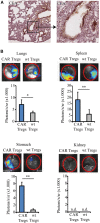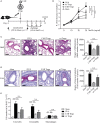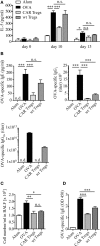Chimeric Antigen Receptor-Redirected Regulatory T Cells Suppress Experimental Allergic Airway Inflammation, a Model of Asthma
- PMID: 28955341
- PMCID: PMC5600908
- DOI: 10.3389/fimmu.2017.01125
Chimeric Antigen Receptor-Redirected Regulatory T Cells Suppress Experimental Allergic Airway Inflammation, a Model of Asthma
Abstract
Cellular therapy with chimeric antigen receptor (CAR)-redirected cytotoxic T cells has shown impressive efficacy in the treatment of hematologic malignancies. We explored a regulatory T cell (Treg)-based therapy in the treatment of allergic airway inflammation, a model for asthma, which is characterized by an airway hyper-reactivity (AHR) and a chronic, T helper-2 (Th2) cell-dominated immune response to allergen. To restore the immune balance in the lung, we redirected Tregs by a CAR toward lung epithelia in mice upon experimentally induced allergic asthma, closely mimicking the clinical situation. Adoptively transferred CAR Tregs accumulated in the lung and in tracheobronchial lymph nodes, reduced AHR and diminished eosinophilic airway inflammation, indicated by lower cell numbers in the bronchoalveolar lavage fluid and decreased cell infiltrates in the lung. CAR Treg cells furthermore prevented excessive pulmonary mucus production as well as increase in allergen-specific IgE and Th2 cytokine levels in exposed animals. CAR Tregs were more efficient in controlling asthma than non-modified Tregs, indicating the pivotal role of specific Treg cell activation in the affected organ. Data demonstrate that lung targeting CAR Treg cells ameliorate key features of experimental airway inflammation, paving the way for cell therapy of severe allergic asthma.
Keywords: adoptive cell therapy; allergic asthma; chimeric antigen receptor; ovalbumin mouse model; regulatory T cells.
Figures






Similar articles
-
4-1 BB stimulation inhibits allergen-specific immunoglobulin E production and airway hyper-reactivity but partially suppresses bronchial eosinophilic inflammation in a mouse asthma model.Clin Exp Allergy. 2006 Mar;36(3):377-85. doi: 10.1111/j.1365-2222.2006.02445.x. Clin Exp Allergy. 2006. PMID: 16499650
-
Adalimumab ameliorates OVA-induced airway inflammation in mice: Role of CD4(+) CD25(+) FOXP3(+) regulatory T-cells.Eur J Pharmacol. 2016 Sep 5;786:100-108. doi: 10.1016/j.ejphar.2016.06.002. Epub 2016 Jun 2. Eur J Pharmacol. 2016. PMID: 27262379
-
Bee venom ameliorates ovalbumin induced allergic asthma via modulating CD4+CD25+ regulatory T cells in mice.Cytokine. 2013 Jan;61(1):256-65. doi: 10.1016/j.cyto.2012.10.005. Epub 2012 Oct 31. Cytokine. 2013. PMID: 23121887
-
Regulatory T cells and asthma.Clin Exp Allergy. 2009 Sep;39(9):1314-23. doi: 10.1111/j.1365-2222.2009.03301.x. Epub 2009 Jun 17. Clin Exp Allergy. 2009. PMID: 19538496 Review.
-
Chimeric antigen receptor -T cell therapy: Applications and challenges in treatment of allergy and asthma.Biomed Pharmacother. 2020 Mar;123:109685. doi: 10.1016/j.biopha.2019.109685. Epub 2019 Dec 17. Biomed Pharmacother. 2020. PMID: 31862474 Review.
Cited by
-
New Insights into Immunotherapy Strategies for Treating Autoimmune Diabetes.Int J Mol Sci. 2019 Sep 26;20(19):4789. doi: 10.3390/ijms20194789. Int J Mol Sci. 2019. PMID: 31561568 Free PMC article. Review.
-
Clinical Applications of Regulatory T cells in Adoptive Cell Therapies.Cell Gene Ther Insights. 2018 Jan;4(1):405-429. doi: 10.18609/cgti.2018.042. Cell Gene Ther Insights. 2018. PMID: 34984106 Free PMC article.
-
The Future of Regulatory T Cell Therapy: Promises and Challenges of Implementing CAR Technology.Front Immunol. 2020 Jul 24;11:1608. doi: 10.3389/fimmu.2020.01608. eCollection 2020. Front Immunol. 2020. PMID: 32793236 Free PMC article. Review.
-
Tonic signaling in CAR-T therapy: the lever long enough to move the planet.Front Med. 2025 Jun;19(3):391-408. doi: 10.1007/s11684-025-1130-x. Epub 2025 Mar 21. Front Med. 2025. PMID: 40117019 Review.
-
CAR-NKT Cells in Asthma: Use of NKT as a Promising Cell for CAR Therapy.Clin Rev Allergy Immunol. 2024 Jun;66(3):328-362. doi: 10.1007/s12016-024-08998-0. Epub 2024 Jul 12. Clin Rev Allergy Immunol. 2024. PMID: 38995478 Review.
References
-
- From the Global Strategy for Asthma Management and Prevention. Global Initiative for Asthma (GINA). (2014). Available from: http://www.ginasthma.org/
LinkOut - more resources
Full Text Sources
Other Literature Sources

